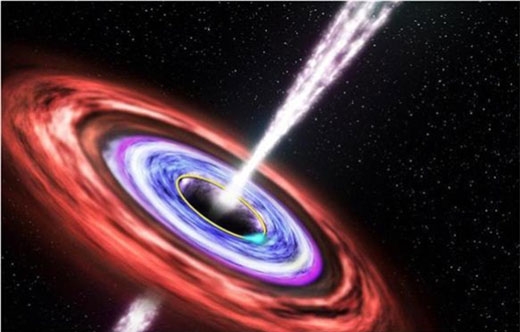It looks like you're using an Ad Blocker.
Please white-list or disable AboveTopSecret.com in your ad-blocking tool.
Thank you.
Some features of ATS will be disabled while you continue to use an ad-blocker.
share:
For so long have we tried to produce/detect dark matter using bulky complex & relatively inefficient machines and whose energy requirements are exorbitant. But we already have naturally-occuring, gigantic (and powerful! ) particle accelerators scattered all over the cosmos - black holes.Since dark matter is subject to gravitational pull just like matter is, then it is highly probable that black holes are constantly crushing down not only normal matter but also dark matter, releasing the latter's mass energy and making a peak in the black hole jet's spectrum.
The prediction
Now, the Singular Primordial Preon Theory has predicted that Dark Matter would come in the form of particles whose mass are 13.4 GeV.
This prediction was based on the formula "SystemMass ((6-x)/3)*((Wm/4)-um)", where x is the number of preons in the system, Wm is the mass of the W boson and um is the mass of the up quark. In the case of dark matter, the SPP Theory predicts the system to hold 4 preons and so gives the formula the following value: ((6-4)/3)*((80.4/4)-0.0024) = 13.3984 GeV.
The release of this mass energy gives a very specific frequency signature, just like striking a tuning fork gives a very specific tone.
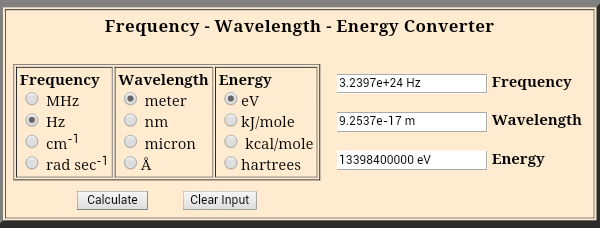
mass energy - frequency converter
To be exact, the frequency released by this predicted dark matter mass energy is 3.2 x 10^24 Hz (that's 3,200,000,000,000 trillion Hertz, or 3.2 YottaHertz).
The miracle peak
It turns out that the observed spectrum of black hole jets features a surprising peak - a peak whose frequency happens to match precisely that of the dark matter predicted by the SPP Theory. The spectrum shows an emission whose frequency is ~3.5 x 10^24 Hz - an astonishing 91% match with the prediction. The peak can be seen in the spectrum of quasar 3C66A:
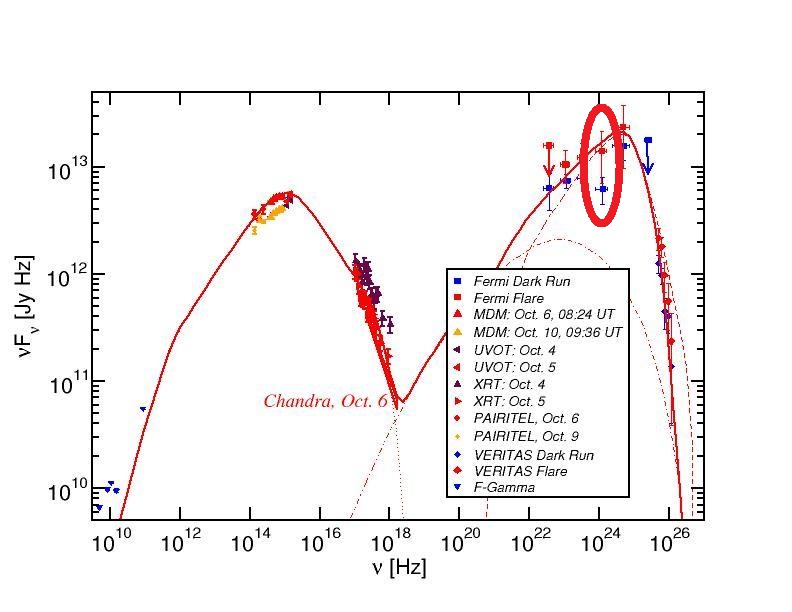
original picture + source
From a paper on the spectrum of blasar 1ES 0806+524:
VERITAS has observed the blasar 1ES 0806+524 for a total 65 hours from November 2006 to April 2008 resulting in the discovery of very-high-energy with a statistical significance of 6.3 sigma. (...)the inverse-Compton peak is located at ~3.5 x 10^24 Hz.
www.academia.edu...
Other instruments such as MAGIC are picking up the same specific signature of 3.2 YHz / 13 GeV.
The synchrotron and inverse Compton peak positions (νsync ≈ 10^16 Hz, νIC ≈10^24 Hz, corresponding to ∼41 eV and∼13GeV) derived for the SED from 2008 (Acciari et al. 2009) and MAGIC observations presented in this paper are located at the same order of frequency.
arpi.unipi.it...
~
The same peak position is reported all over the universe, in the jet spectrum of different active black holes and by different instrumentations.
NGC 1068:
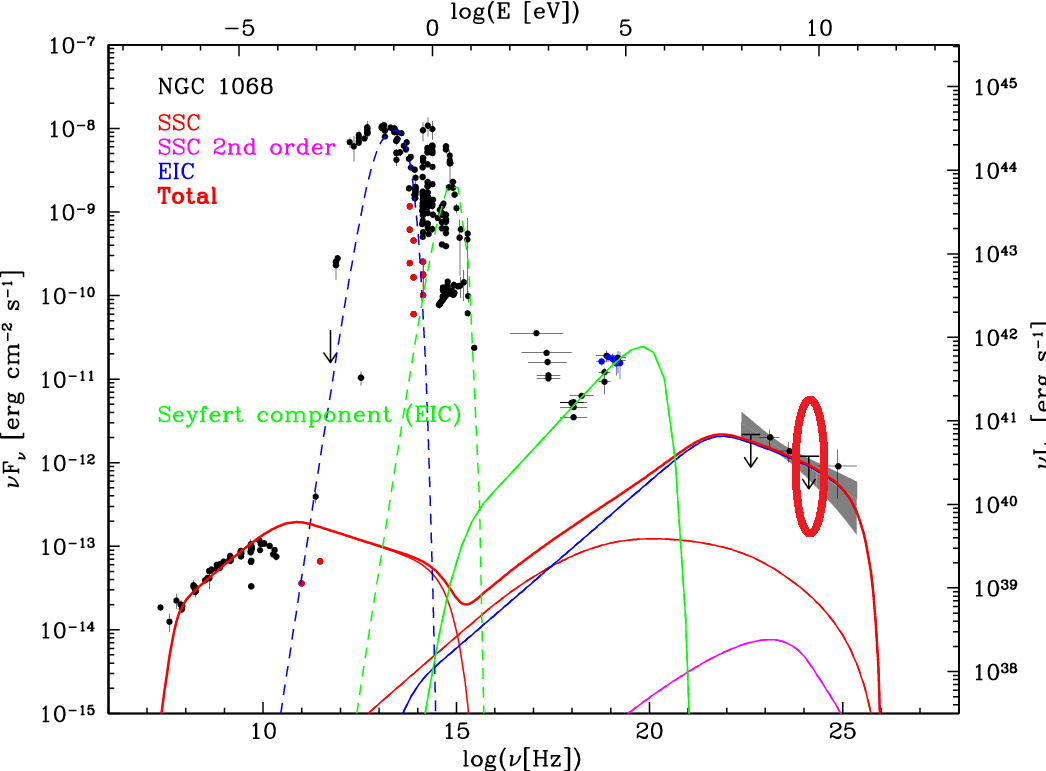
original picture + source
BL Lacertae, spectrum obtained using EGRET:
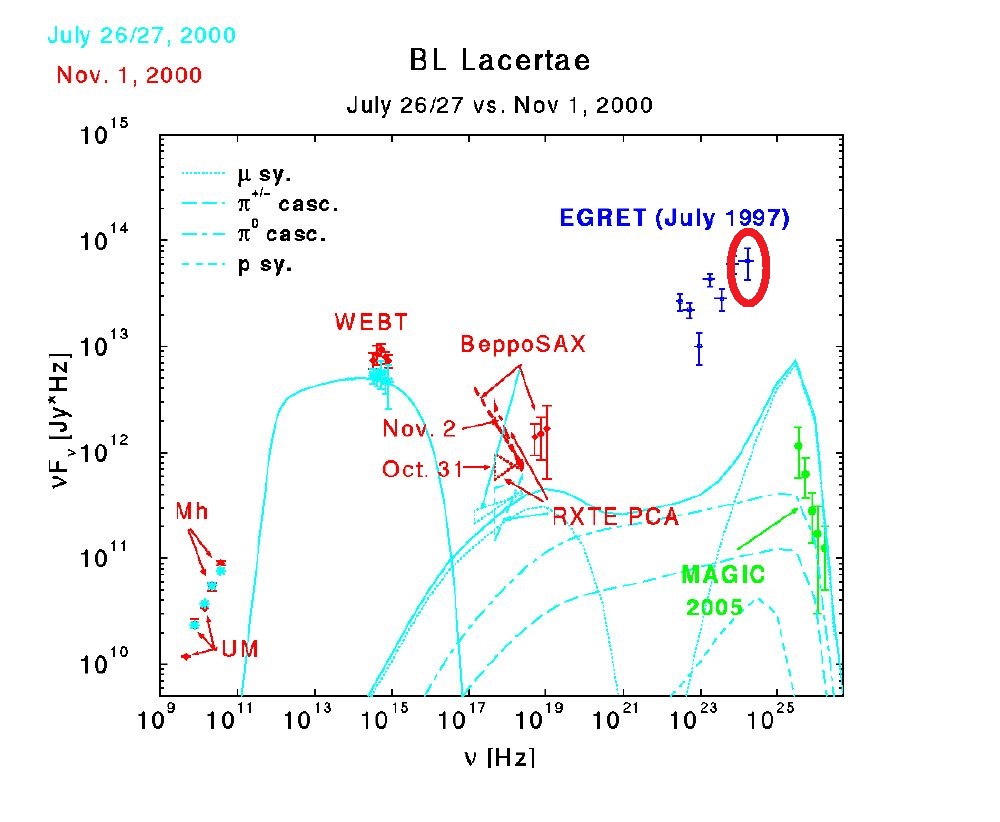
original picture + source
Catalogued blasar using ALMA:
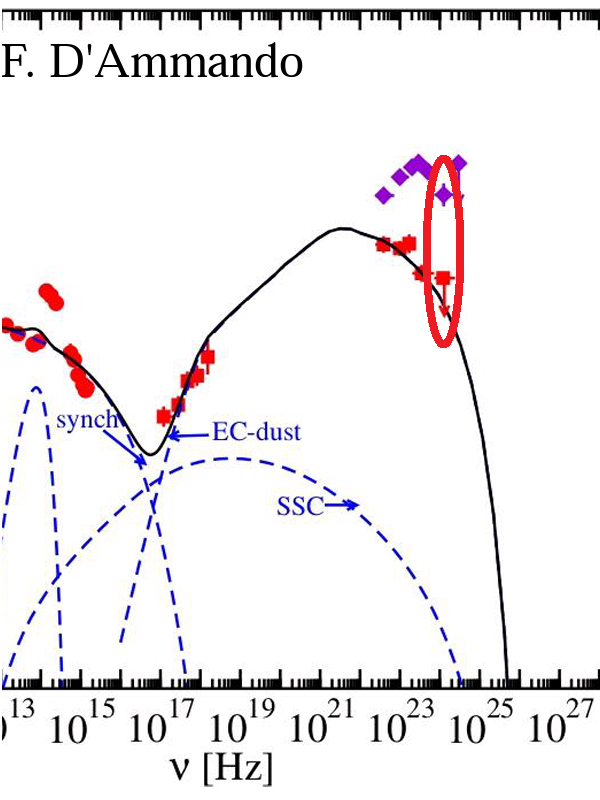
original picture + source
Science community taken by surprise
The origin of the peak came as a mystery to the scientific community, and they assumed that the cause was a process of electron cooling. However, this assumption was proven incomplete when in 2016 black hole jets were discovered to be defeating electron cooling.
New observations of a jet-emitting black hole show astonishing temperatures inside the jets of 10 trillion degrees Kelvin — a toasty 18 trillion degrees Fahrenheit. This new measurement shows that quasars can blow far past the theoretical temperature limit of 100 billion degrees Kelvin (179 billion degrees Fahrenheit), which has scientists puzzled.
Discovery News
Instead of electron cooling, it is quite possible that the observed 3.5 YHz / 13 GeV emission peak is actually caused by dark matter getting crushed in the accretion disk of the black hole, releasing its mass energy in the process.
conclusion
This could very well constitute an important discovery - for the first time ever we may be witnessing the very "resonance" of Dark Matter, the energy it emits as it gets torn apart by the force of black holes. Furthermore, the same peak is observed in various black holes from everywhere in the Universe, giving multiple confirmations of the discovery.
We live in exciting times!
I'd like to give credit to moderator Kandinsky for his support in the creation of this thread, which took me two weeks to put together. I also have
the rest of ATS to thank, for the idea of looking into quasar spectral data came to me as I was browsing the site. A key word, a picture, I wish I
could remember what it was, sparked the thought process and led me to dig deeper and deeper.
I do believe this potential dark matter signature is an important discovery. It represents something important - it reminds us all that if we set our differences aside for a second, and put our minds together, we can achieve such much more.
ATS for the win!
At Time's End,
Swan
I do believe this potential dark matter signature is an important discovery. It represents something important - it reminds us all that if we set our differences aside for a second, and put our minds together, we can achieve such much more.
ATS for the win!
At Time's End,
Swan
a reply to: swanne
good thread mate.
but imo negative on detection of dark matter.
dark matter is what gives mass to particles without reacting in anyway with the particle.
its only a matter of time when it will be accepted that dark matter is only electrons coupled with time residing in the time domain
good thread mate.
but imo negative on detection of dark matter.
dark matter is what gives mass to particles without reacting in anyway with the particle.
its only a matter of time when it will be accepted that dark matter is only electrons coupled with time residing in the time domain
a reply to: Joneselius
Long story.
a reply to: Nochzwei
Except that electrons don't have near enough mass to account for the galactic rotation curve. Electrons are only 0.511 MeV. That's like one of the less massive particles possible.
Long story.
a reply to: Nochzwei
Except that electrons don't have near enough mass to account for the galactic rotation curve. Electrons are only 0.511 MeV. That's like one of the less massive particles possible.
edit on 29-7-2016 by swanne because: (no reason given)
originally posted by: swanne
For so long have we tried to produce/detect dark matter using bulky complex & relatively inefficient machines and whose energy requirements are exorbitant. But we already have naturally-occuring, gigantic (and powerful! ) particle accelerators scattered all over the cosmos - black holes.Since dark matter is subject to gravitational pull just like matter is, then it is highly probable that black holes are constantly crushing down not only normal matter but also dark matter, releasing the latter's mass energy and making a peak in the black hole jet's spectrum.
The prediction
Now, the Singular Primordial Preon Theory has predicted that Dark Matter would come in the form of particles whose mass are 13.4 GeV.
This prediction was based on the formula "SystemMass ((6-x)/3)*((Wm/4)-um)", where x is the number of preons in the system, Wm is the mass of the W boson and um is the mass of the up quark. In the case of dark matter, the SPP Theory predicts the system to hold 4 preons and so gives the formula the following value: ((6-4)/3)*((80.4/4)-0.0024) = 13.3984 GeV.
The release of this mass energy gives a very specific frequency signature, just like striking a tuning fork gives a very specific tone.
mass energy - frequency converter
To be exact, the frequency released by this predicted dark matter mass energy is 3.2 x 10^24 Hz (that's 3,200,000,000,000 trillion Hertz, or 3.2 YottaHertz).
The miracle peak
It turns out that the observed spectrum of black hole jets features a surprising peak - a peak whose frequency happens to match precisely that of the dark matter predicted by the SPP Theory. The spectrum shows an emission whose frequency is ~3.5 x 10^24 Hz - an astonishing 91% match with the prediction. The peak can be seen in the spectrum of quasar 3C66A:
original picture + source
From a paper on the spectrum of blasar 1ES 0806+524:
VERITAS has observed the blasar 1ES 0806+524 for a total 65 hours from November 2006 to April 2008 resulting in the discovery of very-high-energy with a statistical significance of 6.3 sigma. (...)the inverse-Compton peak is located at ~3.5 x 10^24 Hz.
www.academia.edu...
Other instruments such as MAGIC are picking up the same specific signature of 3.2 YHz / 13 GeV.
The synchrotron and inverse Compton peak positions (νsync ≈ 10^16 Hz, νIC ≈10^24 Hz, corresponding to ∼41 eV and∼13GeV) derived for the SED from 2008 (Acciari et al. 2009) and MAGIC observations presented in this paper are located at the same order of frequency.
arpi.unipi.it...
~
The same peak position is reported all over the universe, in the jet spectrum of different active black holes and by different instrumentations.
NGC 1068:
original picture + source
BL Lacertae, spectrum obtained using EGRET:
original picture + source
Catalogued blasar using ALMA:
original picture + source
Science community taken by surprise
The origin of the peak came as a mystery to the scientific community, and they assumed that the cause was a process of electron cooling. However, this assumption was proven incomplete when in 2016 black hole jets were discovered to be defeating electron cooling.
New observations of a jet-emitting black hole show astonishing temperatures inside the jets of 10 trillion degrees Kelvin — a toasty 18 trillion degrees Fahrenheit. This new measurement shows that quasars can blow far past the theoretical temperature limit of 100 billion degrees Kelvin (179 billion degrees Fahrenheit), which has scientists puzzled.
Discovery News
Instead of electron cooling, it is quite possible that the observed 3.5 YHz / 13 GeV emission peak is actually caused by dark matter getting crushed in the accretion disk of the black hole, releasing its mass energy in the process.
conclusion
This could very well constitute an important discovery - for the first time ever we may be witnessing the very "resonance" of Dark Matter, the energy it emits as it gets torn apart by the force of black holes. Furthermore, the same peak is observed in various black holes from everywhere in the Universe, giving multiple confirmations of the discovery.
We live in exciting times!
Well I'm glad we got that cleared up.
a reply to: swanne
Everything here looks fantastic. I am stuck on the 91% part. It it is so very close. But could it be something else?
I mean to say possibly an unnamed particle. 91% is very close to the dark matter number. But when talking about things so small, it is actually somewhat of a gap.
Everything here looks fantastic. I am stuck on the 91% part. It it is so very close. But could it be something else?
I mean to say possibly an unnamed particle. 91% is very close to the dark matter number. But when talking about things so small, it is actually somewhat of a gap.
edit on 29-7-2016 by reldra because: (no reason given)
edit on 29-7-2016 by reldra because: (no reason
given)
a reply to: reldra
Well there's also the fact that observations have a level of uncertainty. Notice that in the paper they observed the spectral peak to be located at about 3.5 x 10^24 Hz, whereas I predicted 3.2 x 10^24 Hz.
Same thing with the second paper I quote from. It says about 13 GeV, whereas I predicted 13.4 GeV.
Well there's also the fact that observations have a level of uncertainty. Notice that in the paper they observed the spectral peak to be located at about 3.5 x 10^24 Hz, whereas I predicted 3.2 x 10^24 Hz.
Same thing with the second paper I quote from. It says about 13 GeV, whereas I predicted 13.4 GeV.
originally posted by: Nochzwei
a reply to: swanne
good thread mate.
but imo negative on detection of dark matter.
dark matter is what gives mass to particles without reacting in anyway with the particle.
its only a matter of time when it will be accepted that dark matter is only electrons coupled with time residing in the time domain
Dark matter is dark matter. It is not time or time coupled with anything else. Time may be a particle in and of itself, though. It's behavior at the event horizon of a black hole may be they way to find it. That is why I find this thread so interesting. I am interested in what it actually found, as the number is close but not quite there.
Dark matter cannot give mass to anything that is not dark matter.
edit on 29-7-2016 by reldra because: (no reason given)
originally posted by: swanne
a reply to: reldra
Well there's also the fact that observations have a level of uncertainty. Notice that in the paper they observed the spectral peak to be located at about 3.5 x 10^24 Hz, whereas I predicted 3.2 x 10^24 Hz.
Same thing with the second paper I quote from. It says about 13 GeV, whereas I predicted 13.4 GeV.
It is very close. So I really like everything you posted. It leaves me to wonder, further. But I find no fault in what you have presented. Actually, I find it to be the best post I have read on ATS in a very, very long time. Maybe one of the best things I have read anywhere in a very long time. I focused on things like this for part of university. Whatever is being measured here is an extremely important find. This thread should get applause from each and every mod.
edit on 29-7-2016 by reldra because: (no reason given)
a reply to: swanne
Who, apart from you, is claiming this as a possible explanation?
Instead of electron cooling, it is quite possible that the observed 3.5 YHz / 13 GeV emission peak is actually caused by dark matter getting crushed in the accretion disk of the black hole, releasing its mass energy in the process.
Who, apart from you, is claiming this as a possible explanation?
I think dark mater is Light.
ok! can you See light from the side? no!
light from stars has been running around from the beginning.
even the light from the big bang. that is a lot of Photons.
light Must have some mass, even a small amount.
ok! can you See light from the side? no!
light from stars has been running around from the beginning.
even the light from the big bang. that is a lot of Photons.
light Must have some mass, even a small amount.
a reply to: swanne
Well this conflicts with another report that I've read...
And then there is this from Scientific American who I believe broke the story first.
Sorry to rain on your parade. However I have read another theory that a Bose-Einstein condensate in the vacuum of space could create dark matter, and as we know there is no such thing as empty space and space itself is near to or equal to absolute Zero.
Well this conflicts with another report that I've read...
After 20-month search period, a key dark matter detection experiment has officially come up empty-handed, casting doubt on the existence of weakly interacting massive particles (WIMPS), which have been far and away the leading explanation for one of the biggest mysteries in astrophysics.
And then there is this from Scientific American who I believe broke the story first.
Researchers examined a huge amount of data collected from the carefully calibrated device over the course of the 20-month experiment, which followed on the heels of a less-sensitive, three-month LUX search that ended in 2013, also with a negative result.
Sorry to rain on your parade. However I have read another theory that a Bose-Einstein condensate in the vacuum of space could create dark matter, and as we know there is no such thing as empty space and space itself is near to or equal to absolute Zero.
edit on 29-7-2016 by Thecakeisalie because: (no reason given)
edit on 29-7-2016 by Thecakeisalie because: (no reason
given)
Nice find! Fascinating stuff. 18 trillion degrees wow.
edit on 29-7-2016 by iTruthSeeker because: (no reason given)
I'm too thick to understand it but I'm happy we have more intelligent people then me on the planet to be able to discover stuff like this.
Fascinating.
Question though now we know where it is what can we do with it? what are the practical things we will use dark matter for in the future?.
Fascinating.
Question though now we know where it is what can we do with it? what are the practical things we will use dark matter for in the future?.
new topics
-
Bizarre Labour Party Tic Toc Video Becomes Even More Embarrassing
Regional Politics: 4 hours ago -
Potter to WHU
World Sports: 10 hours ago
top topics
-
The elephant in the room (wearing a hoodie)
US Political Madness: 12 hours ago, 14 flags -
Dr. Demento
Music: 12 hours ago, 6 flags -
Bizarre Labour Party Tic Toc Video Becomes Even More Embarrassing
Regional Politics: 4 hours ago, 4 flags -
Potter to WHU
World Sports: 10 hours ago, 2 flags
active topics
-
Los Angeles brush fires latest: 2 blazes threaten structures, prompt evacuations
Mainstream News • 259 • : marg6043 -
The Acronym Game .. Pt.4
General Chit Chat • 1039 • : JJproductions -
What Is 'Quad Demic'? Mask Mandate Returns In These US States
Diseases and Pandemics • 43 • : DeadlyStaringFrog -
To become president, Zelensky had to learn Ukrainian
Political Conspiracies • 32 • : firerescue -
The elephant in the room (wearing a hoodie)
US Political Madness • 23 • : fringeofthefringe -
President Carter has passed
Mainstream News • 56 • : angelchemuel -
Remember These Attacks When President Trump 2.0 Retribution-Justice Commences.
2024 Elections • 141 • : bluesman023 -
Post A Funny (T&C Friendly) Pic Part IV: The LOL awakens!
General Chit Chat • 8009 • : Cymru -
Bizarre Labour Party Tic Toc Video Becomes Even More Embarrassing
Regional Politics • 8 • : gortex -
What Comes After January 20th
Mainstream News • 39 • : DontTreadOnMe

